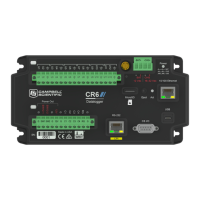l Input voltage must be at least 0.3 V higher than the voltage required to charge the battery;
40 VDC sustained voltage limit without damage. Transient voltage suppressor (TVS) diodes
at the BAT and CHG terminals clamp transients to 19 to 21 V and 19 to 40 V respectively.
Sustained input voltages in excess of 19 V or 40 V respectively can damage the TVS diodes.
BAT Terminals:
l 10 to 18 VDC
l 19 VDC sustained voltage limit without damage; transient voltage protected
l 2.5 A max current at 12 VDC at 20° C; trickle charges the battery
External Batteries:
l Float charge on BAT terminal
l 12 VDC
l Valve-regulated, lead-acid (VRLA)
l 2 to 24 Ah battery typical
USB Power: Functions that will be active with USB5 VDC include sending programs, adjusting
data logger settings, and making some measurements. If USB is the only power source, then the
CS I/O port and the 12V and SW12 terminals will not be operational. When powered by USB (no
other power supplies connected) Status table field Battery = 0.
Internal Lithium Battery: AA, 2.4 Ah, 3.6 VDC (Tadiran TL 5903/S) for battery-backed SRAM and
clock. 3-year life with no external power source. See also Internal battery (p. 116).
Average Current Drain:
Assumes 12 VDC on BAT terminals — add 2 mA if using CHG terminals.
l Idle: <1 mA
l Active 1 Hz Scan: 3 mA
l Active 20 Hz Scan: 67 mA
l Serial (RS-232/RS-485): Active + 25 mA
l Ethernet Power Requirements:
o
Ethernet 1 Minute: Active + 1 mA
o
Ethernet Idle: Active + 4 mA
o
Ethernet Link: Active + 47 mA
Vehicle Power Connection: When primary power is pulled from the vehicle power system, a
second power supply OR charge regulator may be required to overcome the voltage drop at
vehicle start-up.
11. CR6 Specifications 212

